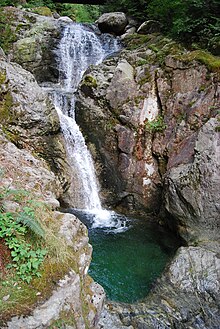Davis Lake Provincial Park
|
Davis Lake Provincial Park
|
||
|
Davis Lake |
||
| location | British Columbia (Canada) | |
| surface | 192 ha | |
| WDPA ID | 65161 | |
| Geographical location | 49 ° 18 ' N , 122 ° 15' W | |
|
|
||
| Setup date | 17th August 1963 | |
| administration | BC parks | |
| particularities | The McDonald Falls | |
The Davis Lake Provincial Park is a 192 ha large Provincial Park in the Canadian province of British Columbia . The park is located at the transition from the Lower Mainland to the Coast Mountains , around 20 kilometers north-northeast of Mission and is part of the Fraser Valley Regional District .
investment
The park lies in a narrow valley floor and is crossed by the access road, which then continues in a north-west direction. The park, which consists of several rectangular areas arranged in the shape of a romboid, has a width of no more than 1 kilometer with a maximum length of about 2 kilometers. On the eastern and western sides, the park rises relatively steeply about 300 to 400 meters on the surrounding mountain slopes.
The heart of the park is the centrally located, eponymous Davis Lake . Several small streams flow into the 26 hectare lake, including Davis Creek and Murdo Creek . At Murdo Creek there is also the McDonald Falls , a small waterfall that falls in several steps a total of about 24 meters.
The park is a category II protected area ( national park ).
history
The park was established in 1963 with a size of 185 acres , which corresponds to around 74.9 hectares. Over time, the status of the park and its size have changed several times.
However, as with almost all provincial parks in British Columbia, this one too, long before the area was settled by immigrants or became part of a park, it was the settlement and hunting / fishing area of various tribes of the First Nations , here mainly the Stó people : lō , was.
Flora and fauna
Within the British Columbia ecosystem, the park area is assigned to the Coastal Western Hemlock Zone . These biogeoclimatic zones are characterized by an identical or similar climate and the same or similar biological and geological conditions. This results in a very similar population of plants and animals in the respective zones.
After extensive felling work in the 1940s, there is no longer any primary forest in the park . However, the trees that have grown back have now reached a diameter of up to 75 centimeters and heights of up to 50 meters. The trees are mainly West American hemlock , but there are also occasional Douglas firs and giant arborvitae . There are also individual vine leaf maples and red alders . The undergrowth of the trees is made up of the various ferns and heather plants. There are raspberries and blueberries as well as rib fern and sword fern (Polystichum munitum).
Due to the small size of the park, there are only larger mammals that are found in the area. In addition to the black bear and the wolf, these are various mule deer and elk . The population of smaller mammals, reptiles and amphibians has not yet been studied in detail. There are also no reliable data on the bird population. However, in addition to the spotted owl, various species of woodpecker such as the sap licker have been spotted. Various fish can be found in the 30 meter deep lake. In addition to the cutthroat trout, this also includes the Ptychocheilus oregonensis (in English Squawfish or Pikeminnow ).
Neighboring parks
There are other provincial parks in the area. The Golden Ears Provincial Park is of particular interest , as it is possible to spend the night here with tents and mobile homes for longer periods.
activities
The park is a small park for day visitors. It does not offer extensive tourist infrastructure. The main focus of the visitors are the two beaches on the north and south banks of the lake and the waterfall. Camping in the park is generally allowed, but no areas have been prepared for it. The park has no sanitary facilities. Various hiking trails have been created in the park.
Web links
- Davis Lake Provincial Park . In: BC Geographical Names (English)
- Davis Lake Provincial Park . In: English language website of the park at BC Parks
Individual evidence
- ↑ McDonald Falls. www.worldwaterfalldatabase.com, accessed March 19, 2013 .
- ↑ World Database on Protected Areas - Davis Lake Park (English)
- ↑ Management plan. (PDF, 9.85 MB) British Columbia Ministry of Environment, Lands and Parks , April 2002, accessed on March 19, 2013 .
- ^ Ecosystems of British Columbia. (PDF, 10.31 MB) British Columbia Ministry of Forests, Lands and Natural Resource Operations , February 1991, accessed on March 19, 2013 .
- ↑ Biogeoclimatic Zones of British Columbia. British Columbia Ministry of Forests, Lands and Natural Resource Operations, accessed May 3, 2016 .


